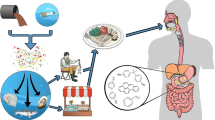Abstract
The objective of this study was to investigate the uptake of dietary DNA into blood, kidney, and liver of salmon, and to determine the DNA fragment size if dietary DNA was detected. Salmon in groups of five fish were force-fed a feed containing a high copy number of three polymerase chain reaction (PCR) amplified DNA fragments. Tissue samples were dissected from the fish at time intervals starting at 1 h after force-feeding (AFF) and ending at 64 h AFF. Real-time PCR analyses were used to determine the presence or absence of DNA targets. Sensitive methods amplifying small fragments were used to minimise the impact of fragmentation on the detectability of DNA targets. Uptake of dietary DNA was observed and the highest concentrations of dietary DNA in liver and kidney were found 8 h AFF. The results correspond to data published for similar trials performed on other animal species. An additional experiment showed that decontamination of the liver surface by flaming has the potential to decrease DNA contamination from, for example, feed remnants by up to 90%.




Similar content being viewed by others
References
EPA (Environmental Protection Agency) (2000) Environmental Protection Agency Federal Register 65, October 31:65245–65251
Orlandi PA, Lampel KA, South PK, Assar SA, Carter L, Levy DD (2002) J Food Prot 65:426–431
Holst-Jensen A, Rønning SB, Løvseth A, Berdal KG (2003) Anal Bioanal Chem 375:985–993
Schubbert R, Renz D, Schmitz B, Doerfler W (1997) PNAS 94:961–966
Doerfler W, Schubbert R (1998) Wien Klin Woechenschr 110:40–44
Schubbert R, Hohlweg U, Renz D, Doerfler W (1998) Mol Gen Genet 259:569–576
Einspanier R, Klotz A, Kraft J, Aulrich K, Poser R, Schwagele F, Jahreis G, Flachowsky G (2001) Eur Food Res Tech 212:129–134
Reuter T, Aulrich K (2003) Eur Food Res Tech 216:185–192
Tony MA, Butschke A, Broll H, Grohmann L, Zagon J, Halle I, Dãnicke S, Schauzu M, Hafez HM, Flachowsky G (2003) Arch Anim Nutr 57:235–252
Windels P, Taverniers I, Depicker A, Bockstaele E, De Loose M (2001) Eur Food Res Tech 213:107–112
Hupfer C, Hotzel H, Sachse K, Engel KH (1998) Z Lebensm Unters Forsch A 206:203–207
Brodmann PD, Ilg EC, Berthoud H, Herrmann A (2002) J AOAC Int 85:646–653
Berdal KG, Holst-Jensen A (2001) Eur Food Res Tech 213:432–438
NMKL (2002) Measurement of uncertainty in microbiological examination in foods NMKL-procedure No 8, 2nd Ed 2002
Krogdahl Å, Nordrum S, Sørensen M, Brudeseth L, Røsjø C (1999) Aquaculture Nutrition 5:121–133
Bakke-McKellep AM, Nordrum S, Krogdahl Å, Buddington RK (2000) Fish Physiol Biochem 22:33–44
Netherwood T, Martìn-Orùe MS, O’Donell GA, Gockling S, Graham J, Mathers JC, Gilbert JH (2004) Nature Biotechnol 22:204–209
Chowdhury EH, Mikami O, Murata H, Sultana P, Shimada N, Yoshioka M, Guruge KS, Yamamoto S, Miyazaki S, Yamanaka N, Nakajima Y (2004) J Food Prot 67:365–370
Chambers PA, Duggan PS, Heritage J, Forbes JM (2002) J Antimicrob Chemoth 49:161–164
Rønning SB, Vaïtilingom M, Berdal KG, Holst-Jensen A (2003) Eur Food Res Tech 216:347–354
Klotz A, Einspanier R (1998) Mais 3:109–111
Phipps RH, Deaville ER, Maddison BC (2003) J Dairy Sci 86:4070–4078
Bendich AJ (1987) BioEssays 6:279–282
Beever DE, Kemp CF (2000) Nutrition abstracts and reviews Series B: Livestock feeds and feeding 70:175–182
Bakke-McKellep AM (1999) Intestinal nutrient absorption in Atlantic salmon (Salmo salar L.) and pathophysiological response of the intestinal mucosa to dietary soybean meal. Ph.D. Thesis, Norwegian School of Veterinary Science, Oslo, Norway
Swiss Food Manual (2000) SLMB-Methode 52B/2.1.3/2000 (CD-Rom, Eidgenössische Materialzentrale, PO Box, CH 3000, Bern)
Acknowledgements
This study was supported financially by a grant from the Research Council of Norway (142474/140). This is gratefully acknowledged. We would also like to thank Hannah J. Jørgensen, Svein Stueland, and Ellen Elisabeth Hage for technical assistance.
Author information
Authors and Affiliations
Corresponding author
Rights and permissions
About this article
Cite this article
Nielsen, C.R., Berdal, K.G., Bakke-McKellep, A.M. et al. Dietary DNA in blood and organs of Atlantic salmon (Salmo salar L.). Eur Food Res Technol 221, 1–8 (2005). https://doi.org/10.1007/s00217-005-1160-1
Received:
Published:
Issue Date:
DOI: https://doi.org/10.1007/s00217-005-1160-1




